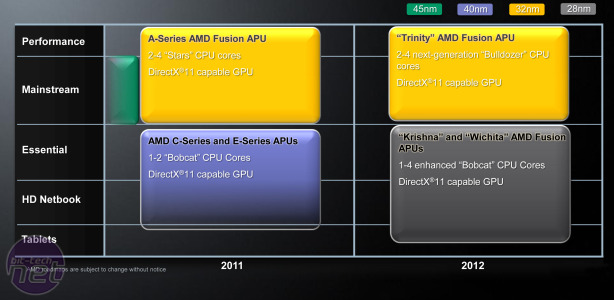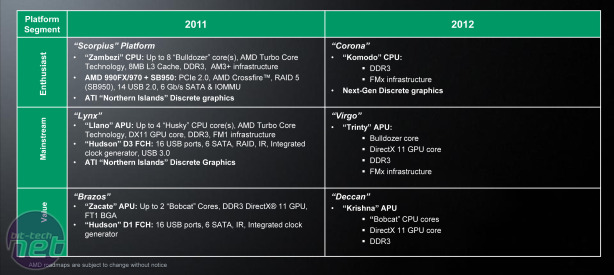
AMD Shows 2012 Roadmap
After months of secrecy, AMD has finally revealed some of its plans for the CPU market in a recent briefing, and there are some curious highlights. For example, next year will see the first ever 28nm AMD processor, meaning that AMD and its fabrication partner GlobalFoundries are keeping pace with Intel fairly well. While Intel is talking about 3D Tri-gate technology for its Ivy Bridge range of CPUs, AMD's new chips will still be fundamentally based on 28nm transistors.While a process shrink usually leads to higher frequencies and more performance, it can also lead to lower power consumption and waste heat if the frequencies aren’t increased. It’s the latter fact that AMD plans to use to its advantage, as the Krishna and Wichita APUs for ‘Essential’ laptops, netbooks and tablets will have exclusive use of 28nm transistors for the year.
These APUs are based on the Bobcat architecture, which is designed to be frugal with power without being horrifically slow. While the current Bobcat-based APUs only feature up to two cores, there will be quad-core APUs in next year’s range.
Meanwhile, performance junkies will be able to play with the Trinity Fusion APUs. These will be based on the Bulldozer architecture, which looks set to offer a big performance improvement over the Husky-based CPU core design of the recently announced Llano range of APUs (look out for more information about this later today).
Interestingly, Trinity is still classed as belonging to a mainstream platform (codenamed Virgo) with a whole level of even faster kit above it. Interestingly, the top-end processor, codenamed Komodo is listed as a CPU, while Trinity is listed as an APU, suggesting that this chip may not have an integrated graphics core.
According to the roadmap, Komodo will be a part of a platform codenamed Corona, which also has some mysterious specifications within it, such as the ‘FMx infrastructure.’ This is also shared with the Virgo platform below it and, as the current socket for mainstream Llano APUs is called FM1, this suggests that the CPUs will use a similar socket architecture.
Anyway, there are some codename to keep watching for the next year or so, and some of AMD’s plans for the future. Let us know if they’re exciting enough for you in the forums, and look out for more details about AMD's Llano CPU architecture later today.

MSI MPG Velox 100R Chassis Review
October 14 2021 | 15:04










Want to comment? Please log in.